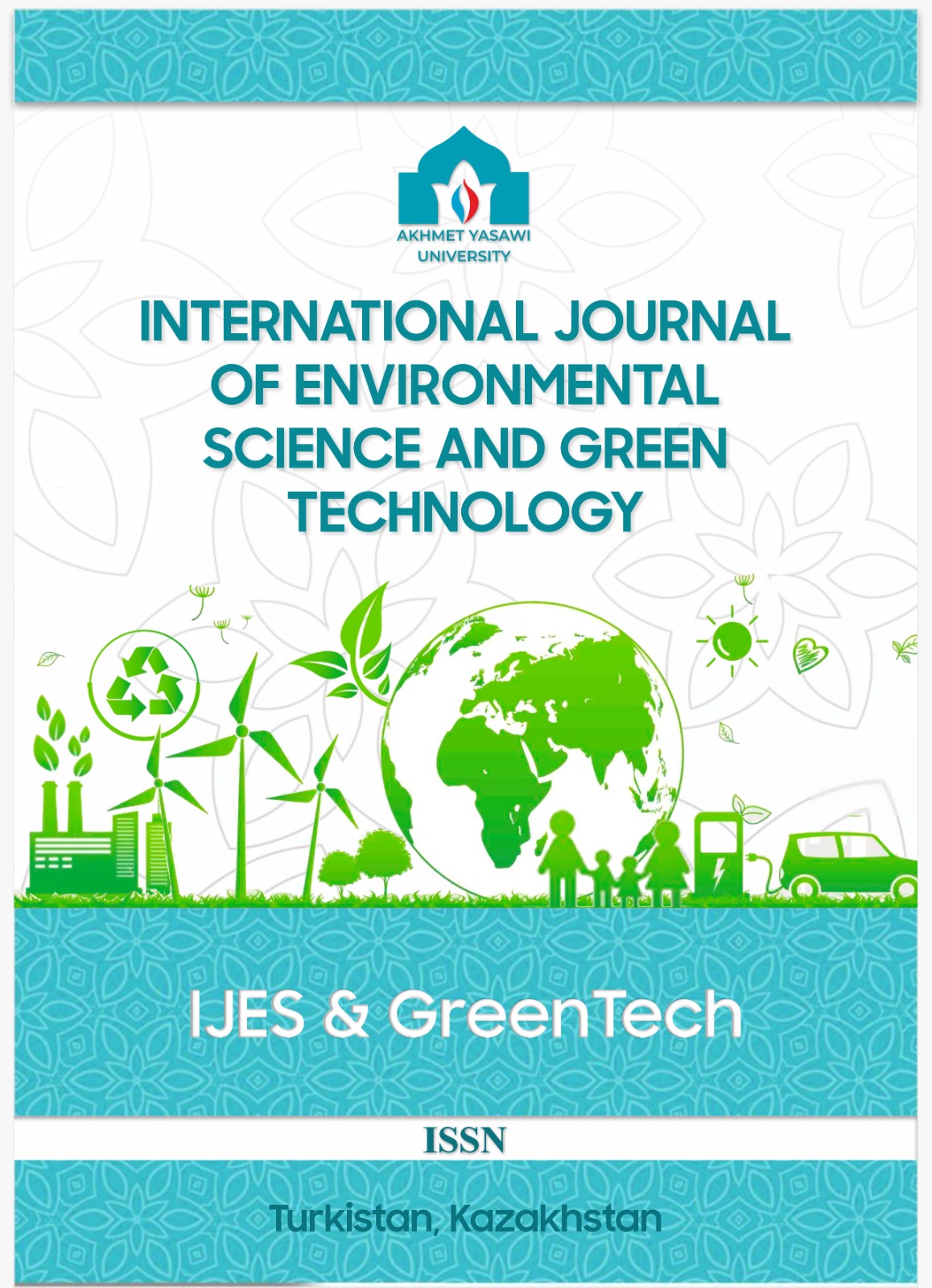Fish as Bioindicators: Monitoring Environmental Mercury Pollution with Aquatic Food Webs – A Mini Review
296 105
DOI:
https://doi.org/10.5281/zenodo.15743911Ключевые слова:
Mercury Pollution, Fish Bioindicators, Bioaccumulation, Aquatic Foodwebs, Environmental MonitoringАннотация
Mercury pollution remains a persistent concern in aquatic ecosystems due to its persistence, bioaccumulation, and toxicity. Fish, as long-lived, trophically diverse organisms, are extremely effective bioindicators of mercury pollution, providing information on spatial and temporal ecosystem pollution trends. The following mini-review consolidates current information on the utilization of fish in tracing environmental mercury, with an emphasis on mercury uptake dynamics, bioaccumulation, and biomagnification along aquatic food chains. Special attention is given to the species-specific patterns of mercury deposition, physiologic and ecological regulation of mercury retention, and regional case studies demonstrating the application of fish-based biomonitoring. Brief overview is given of analytical methods used for the determination of total mercury and methylmercury in fish tissues, as well as recent advances in stable isotope tracing and molecular biomarkers. Besides, the review also addresses the impact of mercury-contaminated fish consumption on human health, coupling environmental monitoring with public health risk assessment. Last but not least, fish are an integrative tool to assess ecosystem integrity, determine pollution sources, and support regulatory mechanisms in mercury risk management.
Библиографические ссылки
Albora, A. M., Sayın, N., & Uçan, O. N. (2006). Evaluation of tectonic structure of İskenderun Basin (Turkey) using steerable filters. Marine Geophysical Researches, 27(4), 225–239. http://www.doi.org/10.1007/s11001-006-9002-5
Bloom, N. S. (1992). On the chemical form of mercury in edible fish and marine invertebrate tissue. Canadian Journal of Fisheries and Aquatic Sciences, 49(5), 1010–1017. https://doi.org/10.1139/f92-113
Bravo, A. G., Cosio, C., Amouroux, D., Zopfi, J., Chevalley, P. A., Spangenberg, J. E., & Ungureanu, V. G. (2022). Mercury transformations and transfer in aquatic systems: Insight from stable isotope studies. Nature Reviews Earth & Environment, 3(9), 681–694. https://doi.org/10.1038/s43017-022-00319-z
Burger, J., & Gochfeld, M. (2011). Conceptual frameworks for the assessment of contaminant effects on fish. Environmental Research, 111(4), 578–586. https://doi.org/10.1016/j.envres.2010.09.006
Cabana, G., & Rasmussen, J. B. (1994). Modeling food chain structure and contaminant bioaccumulation using stable nitrogen isotopes. Nature, 372(6503), 255–257. https://doi.org/10.1038/372255a0
Drevnick, P. E., Sandheinrich, M. B., Oris, J. T., & Wiener, J. G. (2012). Natural resource damage assessment: Ecotoxicological evaluations of mercury in fish. Environmental Toxicology and Chemistry, 31(6), 1316–1325. https://doi.org/10.1002/etc.1829
Driscoll, C. T., Mason, R. P., Chan, H. M., Jacob, D. J., & Pirrone, N. (2013). Mercury as a global pollutant: Sources, pathways, and effects. Environmental Science & Technology, 47(10), 4967–4983. https://doi.org/10.1021/es305071v
Eneji, I. S., Sha’Ato, R., & Annune, P. A. (2011). Bioaccumulation of heavy metals in fish from around wastewater discharge points in River Benue, Nigeria. American Journal of Environmental Sciences, 7(2), 103–108. https://doi.org/10.3844/ajessp.2011.103.108
Gilmour, C. C., Podar, M., Bullock, A. L., Graham, A. M., Brown, S. D., Somenahally, A. C., & Elias, D. A. (2013). Mercury methylation by novel microorganisms from new environments. Environmental Science & Technology, 47(20), 11810–11820. https://doi.org/10.1021/es403075t
Green, N. W., et al. (2007). Mercury levels in Atlantic salmon (Salmo salar) in Norwegian rivers. Environmental Monitoring and Assessment, 127(1–3), 249–259. https://doi.org/10.1007/s10661-006-9273-2
Hintelmann, H., Harris, R., Heyes, A., Hurley, J. P., Kelly, C. A., Krabbenhoft, D. P., ... & Rudd, J. W. M. (2002). Reactivity and mobility of new and old mercury deposition in a boreal forest ecosystem during spring runoff. Environmental Science & Technology, 36(5), 941–946. https://doi.org/10.1021/es011016v
Karimi, R., Frisk, M., & Fisher, N. S. (2013). Contrasting food web factor and body size relationships with mercury and selenium in marine biota. PLoS ONE, 8(9), e74695. https://doi.org/10.1371/journal.pone.0074695
Lavoie, R. A., Jardine, T. D., Chumchal, M. M., Kidd, K. A., & Campbell, L. M. (2013). Biomagnification of mercury in aquatic food webs: A worldwide meta-analysis. Environmental Science & Technology, 47(23), 13385–13394. https://doi.org/10.1021/es403103t
Martín-Doimeadios, R. C., Monperrus, M., Krupp, E., Amouroux, D., Donard, O. F. X., & Bravo, A. G. (2004). Evaluation of analytical techniques for mercury speciation in fish. Analytica Chimica Acta, 526(1), 1–12. https://doi.org/10.1016/j.aca.2004.08.037
Mergler, D., Anderson, H. A., Chan, L. H., Mahaffey, K. R., Murray, M., Sakamoto, M., & Stern, A. H. (2007). Methylmercury exposure and health effects in humans: A worldwide concern. Ambio, 36(1), 3–11. https://doi.org/10.1579/0044-7447(2007)36[3:MEAHEI]2.0.CO;2
Munthe, J., Wängberg, I., & Iverfeldt, Å. (2007). Mercury in aquatic environments: Transport and transformation. Water, Air, & Soil Pollution, 111(1), 189–211. https://doi.org/10.1007/BF02448150
Ramlal, P. S., Rudd, J. W. M., & Hecky, R. E. (2003). Mercury in fish from the Lake Victoria ecosystem. Environmental Pollution, 121(2), 287–297. https://doi.org/10.1016/S0269-7491(02)00259-7
Scheuhammer, A. M., Meyer, M. W., Sandheinrich, M. B., & Murray, M. W. (2007). Effects of environmental methylmercury on the health of wild birds, mammals, and fish. AMBIO: A Journal of the Human Environment, 36(1), 12–18. https://doi.org/10.1579/0044-7447(2007)36[12:EOEMOT]2.0.CO;2
Storelli, M. M., Giacominelli-Stuffler, R., Storelli, A., & Marcotrigiano, G. O. (2002). Total and methylmercury residues in tuna-fish from the Mediterranean Sea. Food Additives and Contaminants, 19(8), 715–720. https://doi.org/10.1080/02652030210153575
Ullrich, S. M., Tanton, T. W., & Abdrashitova, S. A. (2001). Mercury in the aquatic environment: A review of factors affecting methylation. Critical Reviews in Environmental Science and Technology, 31(3), 241–293. https://doi.org/10.1080/20016491089226
UNEP. (2019). Global Mercury Assessment 2018. United Nations Environment Programme, Chemicals and Health Branch. https://www.unep.org/resources/publication/global-mercury-assessment-2018
Zhang, Y., Jacob, D. J., Horowitz, H. M., et al. (2021). Global sources and sinks of mercury: Modeling atmospheric transport and deposition. Nature Geoscience, 14, 63–69. https://doi.org/10.1038/s41561-020-00652-2

